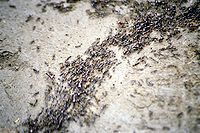
Photo from wikipedia
The influence of the pre-annealing on Mn partitioning behavior was investigated for hot-rolled Fe–0.095C–6.93Mn–1Al–1.07Si medium-Mn-TRIP steel. Unlike the fully martensitic microstructure before one-step intercritical annealing, a mixed microstructure of preexisting… Click to show full abstract
The influence of the pre-annealing on Mn partitioning behavior was investigated for hot-rolled Fe–0.095C–6.93Mn–1Al–1.07Si medium-Mn-TRIP steel. Unlike the fully martensitic microstructure before one-step intercritical annealing, a mixed microstructure of preexisting ferrite, austenite and martensite was obtained prior to the final annealing in two-step annealed steels. The microstructure observation showed that lath-type austenite existed in the martensitic matrix, blocky and granular austenite occurred at the boundaries of primary austenite/preexisting ferrite or martensite/preexisting ferrite after two-step annealing. Based on the numerical simulations of the second annealing process, the preexisting austenite further grew rapidly without nucleation, while some secondary austenite nucleated at the martensitic lath boundaries and then grew into martensite at a relatively sluggish rate. Moreover, significant Mn partitioning with a special “bimodal distribution” feature was detected in the preexisting austenite, resulting in the formation of martensite/austenite constituents. Compared with the case of one-step heat treatment, an excellent combination of strength (1145 MPa) and ductility (39%) was obtained in the steel with pre-annealing, which was ascribed to the occurrence of martensite/austenite islands and positive TRIP effect over a wide strain range.
Journal Title: Journal of Materials Science
Year Published: 2019
Link to full text (if available)
Share on Social Media: Sign Up to like & get
recommendations!